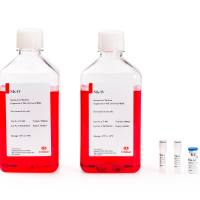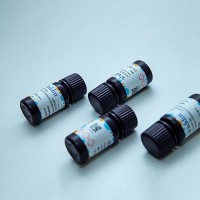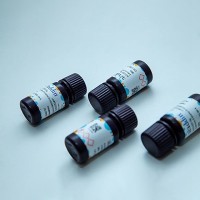NK-cell cytotoxicity assay
互联网
Outline :
To measure NK cell killing, suitable target cells are labeled with 51 Cr, washed and incubated together with the killer cells (and treatments). Large amounts of label is released into the supernatant upon disruption of membrane integrity by the killing process and can be measured in a gamma-counter.
Supplies & Equipment:
- 37°C waterbath (with lead container for 50 ml tube to shield gamma radiation, within a plastic container to prevent lead contamination of the waterbath)
- 50 ml tubes
- round bottom 96-well plates
- centrifuge for 50 ml tubes and 96-well plates
- wet ice
Reagents:
- 51 Cr (sodium chromate in sterile solution, NEZ #030S, DuPont NEN, Wilmington, DE), 1 µCi / µl
- R10 media (= RPMI 1640 + 10% FBS)
- PBS + 2% EDTA
- Triton X-100 solution (10% in dH2 O)
Effector cell preparation:
The mouse NK-cell line KY1 is used as an effector cell. During recovery (e.g. after freezing), these cells require 1000 U/ml IL-2 and a gradually weaned to 50 U/ml IL-2. The evening before the assay (day -1 ), passage the cells from 50 U/ml IL-2 into the desired level of IL-2 for overnight (16h) stimulation. Occasionally, IL-2 levels > 50 U/ml are necessary to maintain killing activity of KY1 cells.
Target cell preparation:
YAC-1 cells are the optimal target for mouse NK cells (KY1). They grow very fast and need to be passaged every other day. Only cells with high viability (>95% in the trypan blue test) should be used. Otherwise, spontaneous release of label will be high and determination of specific killing will be difficult. Passage on day -1 . Seed 2 x 106 cells per flask (20 ml).
Natural killing assay:
- Harvest target cells. Gentle handling will assure low background.
- Count and estimate viability (trypan blue test).
- Adjust cell concentration to 107 cells/ml R10 media in a 50 ml tube. .
- Transfer the required volume (will need ~ 200 µl cell suspension per 96-well plate) into fresh 50 ml tube. The remaining steps use radioactivity , obey safety standards. Think ahead, to cut down exposure time . Maximize distance and use lead shielding .
- Add 50 µl (= 50 µCi) 51 Cr per 200 µl cell suspension. Standard setup would be: 1 ml cell suspension + 250 µl (= 250 µCi) 51 Cr.
- Incubate in at 37°C for 1 h (water in a lead container in a plastic container in a waterbath). Swirl gently every 15 min.
- Spin at 1000 rpm for 5 min, remove supernatant.
- Resuspend in 40 ml prewarmed R10 media, incubate again 1 hour at 37°C with repeated gentle swirling. This allows the removal of the initially high rate of spontaneous leakage and will further minimize background.
- Prepare treatments in 100 µl volume, store on ice. Label 96-well plate.
-
Harvest effector cells using PBS + 2% EDTA, count . Will need > 10 x 106 effector cells. Standard setup: 50 µl effector (2 x 105 cells for E:T 20:1), 50 µl target (1 x 104 cells), 100 µl treatment.
E:T E / 50 µl T / 50 µl E / ml 1:1 1 x 104 104 2 x 105 10:1 1 x 105 104 2 x 106 20:1 2 x 10 5 10 4 4 x 10 6 50:1 5 x 105 104 1 x 107 100:1 1 x 106 104 2 x 107 200:1 2 x 106 104 4 x 107 -
Adjust effector cell concentration
- to 4 x 106 cells / ml (for commonly used E:T of 20:1), aliquot 50 µl into each well (triplicates),
- After 1 hour incubation, spin target cells at 1000 rpm for 5 min. Decant supernatant, resuspend in 40 ml R10 media. Spin again and resuspend in 50 x the original cell suspension volume (i.e. in 10 ml for 200 µl cell initial suspension volume), thereby adjusting the concentration to 104 /50µl. Commonly 5,000 to 50,000 target cells / well are used.
- Aliquot 50 µl to NK cells in 96-well plates.
- Add 100 µl treatment .
- As a negative control (spontaneous release of label) aliquot 3 x 50 µl target cells into 96-well plate. Add 150 µl R10 media.
- As a positive control (maximal release of label upon detergent or freeze/thaw lysis) aliquot 3 x 50 µl target cells into 96-well plate. Add 130 µl R10 media (keep safe distance to other samples to avoid spilling detergent bubbles to other wells; best on separate plate).
- Label plates as being radioactive, incubate at 37°C for 4 hours in 5% CO2 incubator. Longer incubation may occasionally be used, but natural killing should be completed within 4 hours and longer incubation may involve processes other than spontaneous killing (e.g. antibody-mediated cytotoxicity).
- After the incubation, add 20 µl 10% Triton X-100 to each positive control. Pipet up and down to achieve complete lysis.
- Spin 96-well plates at 500 g for 5 minutes.
- Carefully pipet 100 µl of the supernatant into individual tubes. Avoid disturbing the cell pellet, because harvesting of intact targets will erroneously indicate a higher level of killing.
- Count individual tubes in gamma counter. Expected range is between 1,000 - 10,000 cpm for positive control, 100 -2,000 cpm (10-20%) spontaneous release for negative control.
-
Calculate specific cytotoxicity (expected rate for KY1/YAC-1 is ~ 50%):
% specific cytotoxicity = 100 x (exp - spont) / (max - spont)
References :
- Kiessling , R., Klein, E., and Wigzell, H. "Natural" killer cells in the mouse. I. Cytotoxic cells with specificity for mouse Moloney leukemia cells. Specificity and distribution according to genotype. Eur.J.Immunol. 5(2):112-117, 1975.
- Yokoyama , W.M. Natural killer cells and the NK gene complex. In: Cell surface and messenger molecules of the immune system , edited by Weir, D.M., Herzenberg, L.A., and Blackwell, C.Cambridge, MA:Blackwell Science, Inc. 1996,p. 65.1-65.21.









